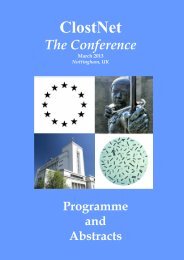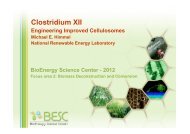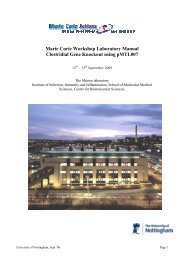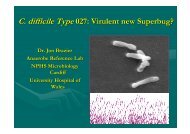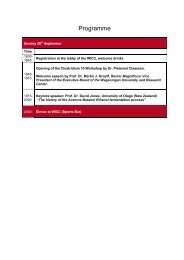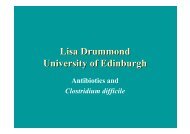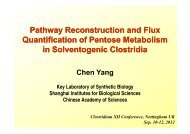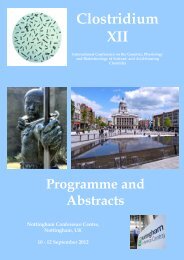abstract book - Clostridia
abstract book - Clostridia
abstract book - Clostridia
You also want an ePaper? Increase the reach of your titles
YUMPU automatically turns print PDFs into web optimized ePapers that Google loves.
EPIDEMIOLOGICAL FINDINGS FROM AFLP ANALYSIS OF 703<br />
CLOSTRIDIUM BOTULINUM STRAINS ISOLATED FROM<br />
CALIFORNIA INFANT BOTULISM PATIENTS 1976-2001<br />
S.S. Arnon 1 , K.K. Hill 2 , J.R. Barash 1 , C. Helma 2 , L. Ticknor 2 , J.R.<br />
Payne 1 , N. Dover 1 and H.A. Dabritz 1<br />
1 Infant Botulism Treatment and Prevention Program, California<br />
Department of Public Health, Richmond, California 94804, USA.<br />
2 Los Alamos National Laboratory, Los Alamos, New Mexico 87544,<br />
USA.<br />
In 1976, coincident with the recognition of infant botulism an as intestinal<br />
toxemia and novel form of human botulism, the now California Department<br />
of Public Health (CDPH) began archiving an isolate of Clostridium<br />
botulinum from every California patient with infant botulism. The patient<br />
address at onset of illness was recorded for all patients, thereby identifying<br />
a geographic location for each isolate. In 2006 CDPH and Los Alamos<br />
National Laboratory began analyzing the California infant botulism strain<br />
collection by the Amplified Fragment-Length Polymorphism (AFLP)<br />
technique using the restriction enzymes EcoR1 and MseI, as described by<br />
Hill et al., J Bacteriol 2007;189:818-832. To date, a total of 703 strains<br />
isolated from California patients during the 25-year period 1976-2001 have<br />
been analyzed, and a dendrogram has been constructed from these<br />
results.<br />
Analysis of the clades in the dendrogram yielded a variety of<br />
epidemiological and microbiological insights. The isolates from the largest<br />
type A (N=312) and type B (N=108) clades were located throughout<br />
California. In contrast, a smaller clade (N=14; 1978-1991) of type B1<br />
isolates localized to the eastern side of San Francisco Bay and the<br />
Sacramento River Delta area. A large clade of type A1 isolates (N=54;<br />
1977-2001) localized almost entirely to San Francisco Bay Area counties<br />
and the Sacramento River counties in the Central Valley. Five smaller<br />
clades of type A isolates representing different parts of California that were<br />
bordered on either side by clades that contained type B isolates were<br />
identified as type A isolates that contained a “silent B” gene [i.e., were<br />
serotype A(B)]. Bivalent (Ba, Bf) isolates grouped into three different<br />
clades. In two clades (one A, one B), isolates from patients living in<br />
different geographical locations were found to be linked to the feeding of<br />
honey.<br />
AFLP analysis of the CDPH collection of C. botulinum infant isolates has<br />
provided novel information about their geographic distribution, genetic<br />
relatedness and epidemiological connectedness that will become better<br />
understood when analysis of the entire collection is completed.<br />
15



